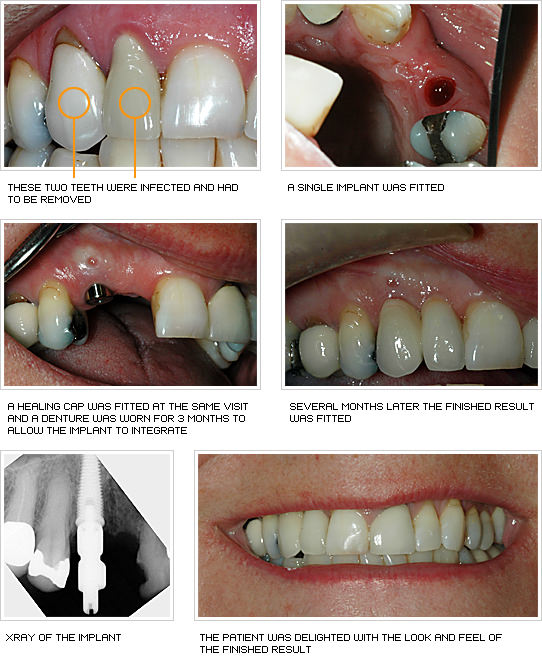The Only Guide for Dental Sense
The Only Guide for Dental Sense
Blog Article
The Only Guide to Dental Sense
Table of ContentsDental Sense for BeginnersThe Facts About Dental Sense UncoveredThe Dental Sense PDFsDental Sense Can Be Fun For Anyone
are medical gadgets surgically implanted right into the jaw to recover an individual's capacity to chew or their look. They give assistance for synthetic (phony) teeth, such as crowns, bridges, or dentures. When a tooth is lost as a result of injury or disease, a person can experience problems such as quick bone loss, malfunctioning speech, or modifications to chewing patterns that result in pain.Oral implant systems contain a dental implant body and oral implant abutment and might additionally include a joint addiction screw. Dental implant vs bridge. The oral implant body is operatively put in the jawbone instead of the tooth's origin. The oral implant abutment is typically connected to the dental implant body by the joint addiction screw and prolongs via gums right into the mouth to support the attached fabricated teeth
(https://pxhere.com/en/photographer-me/4492670)Structure of The Dental Implant System selecting dental implants, talk to your oral provider concerning the possible advantages and risks, and whether you are a prospect for the treatment. Points to take into consideration: Your total health is a vital consider determining whether you are an excellent candidate for dental implants, how long it will require to recover, and how much time the dental implant may remain in location.
Smoking might influence the healing process and reduce the long-term success of the implant. The recovery process for the implant body might take numerous months or longer, during which time you normally have a temporary joint instead of the tooth. the oral implant procedure: Thoroughly comply with the oral health guidelines provided to you by your oral copyright.
The 9-Second Trick For Dental Sense
Implant failing can lead to the demand for one more surgery to fix or change the dental implant system. Brings back the ability to eat Brings back aesthetic appearance Aids keep the jawbone from reducing because of bone loss Protects the health and wellness of the surrounding bone and periodontals Aids maintain surrounding (neighboring) teeth steady Enhances lifestyle Damage to surrounding all-natural teeth during implant placement Injury to the surrounding tissues throughout surgical treatment, such as sinus opening Injury during surgical procedure (for instance, crack of surrounding jawbone) Insufficient function, such as seeming like the teeth do not bite with each other usually A sensation that the tooth hangs or turning in position arising from an abutment screw loosening Implant body failure (looseness of the implant body) due to systemic infection, which might be much more most likely in individuals with unrestrained diabetics issues because of local infection in bone and gum tissues sustaining the implant body because of delayed recovery, which may be more probable in clients who smoke Trouble cleaning the gum tissues around the implant, causing bad dental hygiene Untreated periodontal illness Post-surgical tingling as a result of nerve impingement or damage Constantly notify healthcare carriers and imaging professionals that you have dental implants prior to any type of magnetic vibration imaging (MRI) or x-ray treatments.
FDA is not knowledgeable about any kind of negative occasions reported for MRI or x-ray procedures with dental implants. Oral implants systems are generally constructed from materials that comply with global consensus requirements of the International Company for Standardization (ISO) or ASTM International. These criteria have details of what makes a secure material.

A dental implant is a structure that replaces a missing out on tooth. With screw-like gadgets, the surgeon inserts an implant into the jawbone, and it works as a support for a synthetic tooth, called a crown. A tool called an abutment links the artificial tooth to the dental implant. The crown is tailor-made to fit the person's mouth and match the shade of their teeth.
An Unbiased View of Dental Sense
Some individuals are not qualified for oral implant surgical treatment. It is for dental specialists to run on people with: acute illnessuncontrollable metabolic diseasebone or soft tissue disease or infectionIf these concerns are settled, a person can have the surgical procedure. In, oral surgeons avoid from operating individuals with: If individuals with any of the above go through dental implant surgery, there is a greater danger of the dental implant stopping working.

Dental implant surgical procedure is an individualized process. Provide you time to heal. Connect the post and final crown, bridge or denture.
Next, your doctor will carefully put the oral implant into your jaw. Your surgeon will certainly reposition your gum tissues and shut click this site the incision with stitches. If your dental implant is near the front of your mouth, your dental practitioner will make a momentary tooth for you to use till you recover. In this way, you will not have a void in your smile while you recuperate.
Facts About Dental Sense Uncovered
During the healing stage, your jawbone ought to fuse to the oral implant. This procedure can take anywhere from three to 9 months.
Once your implant heals, your dental professional can affix the abutment (little adapter article) and your final remediation (crown, bridge or denture). This typically takes concerning one hour to complete and may require a 2nd minor surgery. You should not really feel any discomfort during your dental implant procedure since your service provider will utilize medication to numb your gum tissues.
Report this page